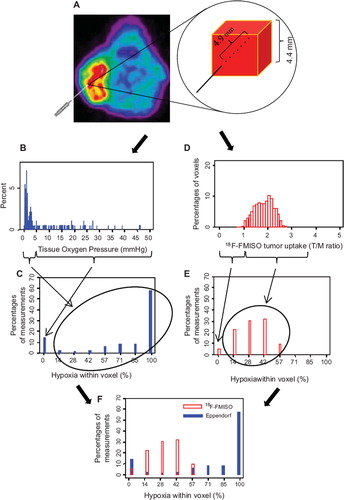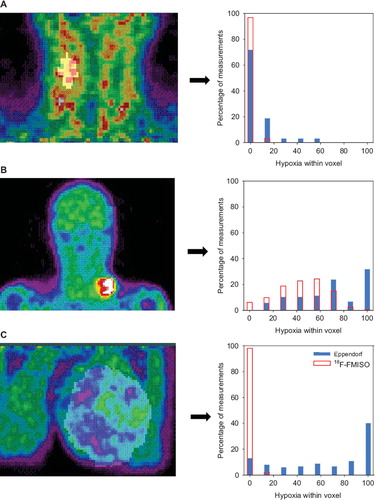Figures & data
Figure 1. The virtual voxel histogram. For each tumor the Eppendorf pO2 measurements of seven successive pO2 values were aligned to resemble signal obtained from an 18F-FMISO PET voxel in one dimension (A). Eppendorf pO2 measurements from patient number 5 (B) converted to a virtual voxel histogram (C). 18F-FMISO PET data from patient number 5 (D) converted to a virtual voxel histogram (E). A corresponding virtual voxel histogram from patient number 2 (F). For direct comparison with the Eppendorf virtual voxel histogram the 18F-FMISO data (percentage of “hypoxia within voxel”) was rounded to nearest seventh part percent (0, 14, 28 … or 100%).

Table I. Patient and tumor characteristics.
Figure 2. Three examples of 18F-FMISO tumor imaging and the corresponding virtual voxel histograms. A: Patient number 1 with concordance between Eppendorf pO2 measurements and 18F-FMISO PET (both showing little/no hypoxia). B: Patient number 12 likewise with concordance between Eppendorf pO2 measurements and 18F-FMISO PET (both showing hypoxia). C: Patient number 15 with lack of con cordance between Eppendorf pO2 measurements (showing high degree of hypoxia) and 18F-FMISO PET (showing very little hypoxia).

Figure 3. Comparison between the virtual voxel median hypoxia measured by Eppendorf pO2 electrodes and 18F-FMISO PET, respectively. The dotted line indicates an ideal situation with total concordance between the two different assays. Red symbol: HNSCC. Blue symbol: Benign tumors. Green symbol: Soft tissue tumors. A, B, C refers to tumor categories as exemplified in .

